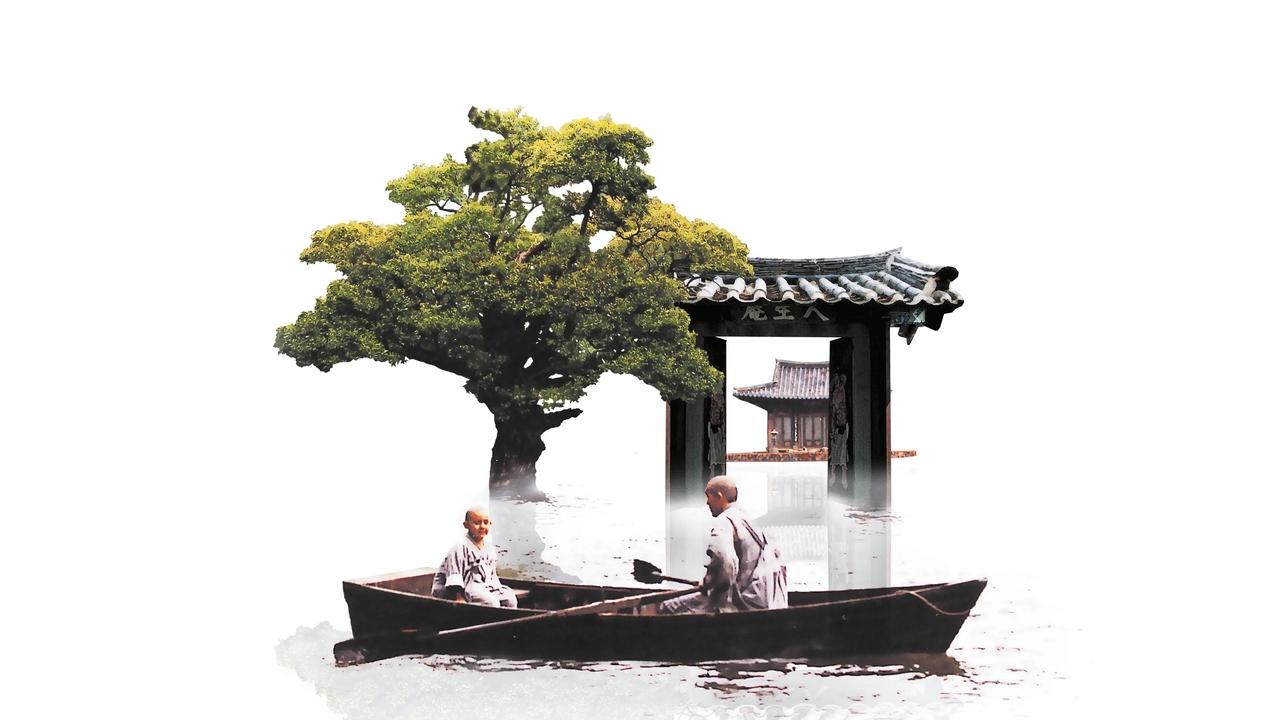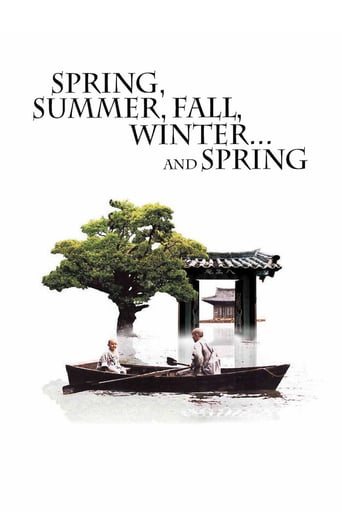

What a stunning and sumptuous idyllic scenery that pond, remarkably sheltered from the perils of modernity. A gorgeous spectacle Mr. Kim Ki-Duk has captured on film for him to weave in a story where both its overt and subtle narratives are rife in symbolic images, Buddhist themes, and animal motifs that complement its sparse dialogue and affecting soundtrack, all helps in depicting the solitude that comes with the monastic life. I hope I could visit that place at least once in my lifetime. How lucky it is for those people who live near those places and witness first-hand the changes in the landscape that each season brings. Blissful.Worth noting in the film is scenes where the young monk having reached his adolescence shows off his Tokyo-Drift-esque skills with a wooden boat to a young woman he very much fancies, a bit of humor. But also be warned because there are scenes that show animals being subjected in varying degrees of disconcerting and distressing situations. My rating: A-plus-plus.
... View MoreThe movie "Spring, Summer, Fall, Winter... and Spring" directed by a vanguard Korean director Kim Ki Duk is a pure illustration and the reading of the Buddhist dharma, core Buddhist teachings. The work can be torn apart into separate pieces of symbolism, yet seen as a complete cyclic work of art. Through the cyclicality of the nature and the life of one person the director could interpret basic Buddhist concept in a lens of cultural Korean Buddhism and the mystical premises which should not be taken presisely. Unlike Weerasethakul's "Uncle Boonmee Who Can Recall His Past Lives" the cyclicality as an essential part of the Buddhist dharma has been shown from a slightly different perspective. The driving force for samsara has not only been the deed of one person, as we have partially observed from Uncle Boonmee, Kim Ki Duk illustrated cyclicality in all aspects of the world: from the rotation of day and night, change in seasons to the evolution of human emotions and senses to the change in generations. Even the title of the movie cyclical, as the Buddhist teachings suggest that time is not linear rather cyclical. Here the viewer comes back to the point zero at the end of the movie as well. It has been illustrated not only through the return to the spring season, which can be seen as the point of rebirth: we see the monk with the little boy both in the beginning and in the end. Other seasons can also be seen as other processes of this cycle: summer is birth, fall is life and winter is death. They can be in different levels at the same time: the development of nature, life of the old monk and life of a little boy. Even though the movie represents the small sangha, the monastic community, everything depicted by the director should not be taken literary, because it involves mystery, which is not explained by the movie. For example, even small details of the monastic life have not been shown and can raise some question: for example, the sources of food they have used to live. Another controversial moment in the movie is the one when the little boy has arrived on another shore and played with fish, frog and snake (which has been shown for the didactic reasons, as the viewer gets to see later), the old monk has also somehow arrived at that side of the shore, possibly just walking on the water. Leaving this questions without the answer, the director almost points out on the fact that even though the representation of the Buddhist livelihood seems more or less accurate, it should not be taken without a doubt. Despite this, Kim Ki Duk masterfully showed 3 Jewels on Buddhism: the Buddha, who has been depicted several times throughout the movie, Sangha, monastic community, and the Dharma, Buddhist core teachings. Even the Dukha, the suffering, which is the main driving force of Samsara, has been shown not only through different types and degrees of physical pain, but also through the moral dissatisfaction and psychological suffering: "Didn't you know beforehand how the world of men is? Sometimes we have to let go of the things we like. What you like, others will also like," - as the old monk commented after the younger one's return to the temple.Even though the movie includes a lot of controversial moments, it could masterly introduce to the viewer core concepts and teaching of Buddhist community, however, the viewer should take responsibility to filter and polish the information.
... View MoreDirected by Kim Ki-duk, and had a lot of positive reviews around the world. This movie tells the story of a person by showing the four seasons of his life which has changed him and taught the philosophy of the Buddhism from his childhood to the older ages. Throughout his life, the Master at the temple was his guide and influenced him. From the start of the movie, an everyday routine of Buddhist monks are shown. Throughout the film, the older master is a representation of a true Buddhist monk, whose views of the world differs from the boy's. He tries to teach the boy through the lesson about pain and guilt, cruel consequences of desire, releasing the anger and about reaching inner peace, but already without being beside. At the end, we can see that the little boy in the past became a master and from spring the cycle begins again with another little apprentice. Through this cycle, I understood that being a person with inner peace is not inborn, but reachable. I want to talk about one interesting thing in this movie. The door which opens the view to the floating monastery, and another two doors in it are actually do not serve as simple doors continued with walls. They are standing alone and anyone could just walk around them. But, mostly people use them as actual doors that help us to enter certain place. Even in the monastery, people sleep behind the doors, open them to look at someone. In my point of view, walking through the door is an established tradition, while breaking this rule is going on a string of desire. I think this symbolizes the teenager, who made a decision in the wake of hormones, and had unexpected consequences. I think the camerawork of this movie should be mentioned. Watching this movie was pleasure because of soft transitions between scenes and stable shooting. Also, cameraman showed the beautiful nature of that forest surrounding the lake and hills. When picture is enjoyable, perception of the movie is always better. The quality of the sound was also good, though the film was shot in 2003. However, the musical accompaniment was not rich. Sometimes, the Buddhist music (?) or sounds come out, but basically they focused on life sounds. Ki-duk said of the film: "I intended to portray the joy, anger, sorrow and pleasure of our lives through four seasons and through the life of a monk who lives in a temple on Jusan Pond surrounded only by nature." To sum up, I would like to say that this movie by Kim Ki-duk is very touching and realistic. All these teachings give an opportunity to all people to get to know with Buddhist religious traditions, philosophy and life of the monks. The story tells us that every monk become himself and reaches inner peace through experiencing and realizing the importance of it. But I think this can be related to anyone, despite the religion, nationality and gender.
... View MoreThis is not a boring art movie. Do not skip this movie thinking it's going to go over your head, even though some of it probably will. This movie will make you think and feel, and it's not a difficult watch like some Tarkovsky film or There Will Be Blood or something like that. It's less than two hours long, it's easy to follow and it has some really profound messages.There is plenty of symbolism that requires knowledge of Buddhism to fully grasp, like the animals present in the movie, or the meaning of the ending sequence, but even without context you can appreciate the story and the characters.Kim Ki-duk's movies are great, some of them are really weird but this one just works even if you go into it totally clueless.So why is it that good? It's got it all - love, passion, crime, forgiveness, repentance. It's got a totally ripped kung fu master, a beautiful young lady totally naked, it's got a floating Buddhist temple in the middle of an idyllic valley, it's got a spell inscribed onto the floor by a cat's tail. It will leave you with questions, but it will also give you answers to questions you didn't know you even had.
... View More